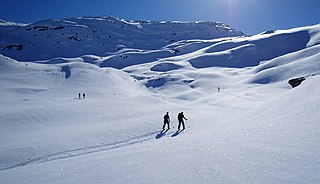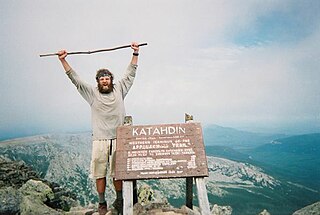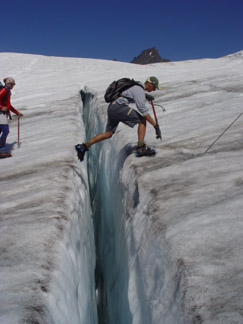
Trekking poles (also known as hiking poles, hiking sticks or walking poles) are a common hiking accessory that function to assist walkers with their rhythm, to provide stability, and reduce strain on joints on rough terrain.

Trekking poles (also known as hiking poles, hiking sticks or walking poles) are a common hiking accessory that function to assist walkers with their rhythm, to provide stability, and reduce strain on joints on rough terrain.

When in use, modern trekking poles resemble ski poles as they have many features in common, such as baskets at the bottom to prevent the pole sinking through unstable surfaces, and rubber-padded handles and wrist straps to strengthen holding grip. Their maximum length is usually 135 cm (54 inches), however, unlike ski poles, they are often made in two or three sections and can be extended and retracted as necessary for use and collapsed for storage or transport. When fully retracted it may be possible to attach them to a backpack. Some poles come with spring-loaded sections to aid walking under normal conditions and to reduce wrist strain, but such devices may only add unwanted weight and noise to the poles. They are usually made from lightweight aluminum or carbon fiber.

Descendants of the common walking stick, trekking poles are usually used by hikers for the same reasons — to provide some rhythm to their walking pace and for added support. On flat, smooth terrain they really aren't necessary although using them can increase the exercise a hiker gets from the trip, as well as increase the speed. But on less certain terrain, or steep slopes, they provide useful lateral stability, and many turn to them for help with knee pain. They can also be used as aids when climbing rocks or boulders, to probe the depth of mud or water and facilitate a crossing. When traversing steep slopes for long distances, some hikers make one pole shorter than the other to make those trips feel more as if they were taking place on level ground.
Some backpacking tents are designed to use trekking poles as tent poles. Along the same lines, trekking poles can be used to set up a Bivouac shelter. Hikers who take to snowshoes in winter find trekking poles especially useful.
They can also be used in Nordic walking in a rural or urban environment.
The Appalachian Trail Conservancy (ATC) estimates that pole usage rates on the Appalachian Trail vary from 90% among thru-hikers to 10–15% among day hikers.[ citation needed ]

Some hikers have complained that pole use can leave a visible impact on the surrounding trail, for instance poking visible holes in the ground and damaging adjacent vegetation. In particular, the most common complaint is that the carbide tips leave visible white scratches on rock and make scraping sounds. All these can detract from the wilderness experience. [1]
The Appalachian Trail Conservancy (ATC) recommends several measures to mitigate the environmental impact of trekking poles in accordance with Leave No Trace principles of low-impact backcountry recreation. Hikers, it says, should not only be aware of what they put their poles into, they should remove the pole baskets unless hiking in snow and use rubber tips to avoid scratch marks on rocks. On level sections, or in areas where the potential for adverse impact is high, the ATC suggests putting the poles away entirely. [1]
"Nordic walking", a type of walking with poles, has been found to have beneficial effects on resting heart rate, blood pressure, exercise capacity, maximal oxygen consumption, and quality of life in patients with various diseases, and to be superior to brisk walking without poles and in some endpoints to jogging. [2] [3]

Cross-country skiing is a form of skiing whereby skiers traverse snow-covered terrain without use of ski lifts or other assistance. Cross-country skiing is widely practiced as a sport and recreational activity; however, some still use it as a means of transportation. Variants of cross-country skiing are adapted to a range of terrain which spans unimproved, sometimes mountainous terrain to groomed courses that are specifically designed for the sport.

The Appalachian Trail, also called the A.T., is a hiking trail in the Eastern United States, extending almost 2,200 miles (3,540 km) between Springer Mountain in Georgia and Mount Katahdin in Maine, and passing through 14 states. The Appalachian Trail Conservancy claims the Appalachian Trail to be the longest hiking-only trail in the world. More than three million people hike segments of the trail each year.

Snowshoes are specialized outdoor gear for walking over snow. Their large footprint spreads the user's weight out and allows them to travel largely on top of rather than through snow. Adjustable bindings attach them to appropriate winter footwear.

Hiking is a long, vigorous walk, usually on trails or footpaths in the countryside. Walking for pleasure developed in Europe during the eighteenth century. Religious pilgrimages have existed much longer but they involve walking long distances for a spiritual purpose associated with specific religions.
Earl V. Shaffer, was an American outdoorsman and author known from 1948 as The Crazy One for attempting what became the first publicized claimed hiking trip in a single season over the entire length of the Appalachian Trail (AT). He also worked as a carpenter, a soldier specializing in radar and radio installation, and an antique dealer.

Nordic walking is a Finnish-origin total-body version of walking that can be done both by non-athletes as a health-promoting physical activity and by athletes as a sport. The activity is performed with specially designed walking poles similar to ski poles.

Backpacking is the outdoor recreation of carrying gear on one's back while hiking for more than a day. It is often an extended journey and may involve camping outdoors. In North America, tenting is common, where simple shelters and mountain huts, widely found in Europe, are rare. In New Zealand, hiking is called tramping, and tents are used alongside a nationwide network of huts. Hill walking is equivalent in Britain, though backpackers make use of a variety of accommodation, in addition to camping. Backpackers use simple huts in South Africa. Trekking and bushwalking are other words used to describe such multi-day trips.

The Chilkoot Trail is a 33-mile (53 km) trail through the Coast Mountains that leads from Dyea, Alaska, in the United States, to Bennett, British Columbia, in Canada. It was a major access route from the coast to Yukon goldfields in the late 1890s. The trail became obsolete in 1899 when a railway was built from Dyea's neighbor port Skagway along the parallel White Pass trail.

Hiking (walking) boots are footwear specifically designed for protecting the feet and ankles during outdoor walking activities such as hiking. They are one of the most important items of hiking gear, since their quality and durability can determine a hiker's ability to walk long distances without injury. Hiking boots are constructed to provide comfort for walking considerable distance over rough terrain. Boots that protect the hiker's feet and heel are recommended. Hiking boots give ankle support and are fairly stiff. A less popular alternative is to use light trainers with thin soles. Footwear should be neither too loose nor too tight, to help prevent blisters and sore feet. Hiking socks that wick sweat from the feet, provide warmth, and cushion the feet are recommended and a thin, inner sock may also help. Most hiking boots are also designed for other outdoor activities such as backpacking, climbing, mountaineering, and hunting.

Trail blazing or way marking is the practice of marking paths in outdoor recreational areas with signs or markings that follow each other at certain, though not necessarily exactly defined, distances and mark the direction of the trail.

The Appalachian Trail Conservancy (ATC) is a nonprofit organization dedicated to the conservation of the Appalachian Trail, a route in the eastern United States that runs from Maine to Georgia. Founded in 1925, the ATC is responsible for the day-to-day management of the Appalachian Trail under a cooperative agreement executed with the National Park Service. It is the lead non-governmental organization in protecting the trail's 2,193 miles (3,529 km), 250,000 acre (1,000 km²) greenway and coordinates the work of some thirty-one Appalachian Trail maintaining clubs performing almost all of the on-the-ground maintenance work. The National Trails System Act, which established the National Trails System and brought the Appalachian Trail into the federal estate, enabled the trail to be managed as it had been since 1925, with central agency and NGO (ATC) coordination, but most trail work being performed by, in 2019, almost 6,000 volunteers.

Thru-hiking, or through-hiking, is the act of hiking an established long-distance trail end-to-end continuously.

Outdoor recreation, such as hiking, camping, canoeing, cycling, or skiing, entails risks, even if participants do not recklessly place themselves in harm's way. In some circumstances, such as being in remote locations or in extreme weather conditions, even a minor accident may create a dangerous situation that requires survival skills. However, with correct precautions, even fairly adventurous outdoor recreation can be enjoyable and safe.

Ultralight backpacking is a style of lightweight backpacking that emphasizes carrying the lightest and least amount of gear. While no technical standards exist, some hikers consider "ultralight" to mean an initial base weight of less than 4.5 kg (9.9 lb). Base weight is the weight of a fully loaded backpack at the start of a trip, excluding worn weight and consumables such as food, water, and fuel. Base weight can be lowered by reducing the weight of individual items of gear, or by choosing not to carry that gear. Ultralight backpacking is most popular among thru-hikers.
The Appalachian National Scenic Trail spans 14 U.S. states over its roughly 2,200 miles (3,500 km): Georgia, North Carolina, Tennessee, Virginia, West Virginia, Maryland, Pennsylvania, New Jersey, New York, Connecticut, Massachusetts, Vermont, New Hampshire, and Maine. The southern end is at Springer Mountain, Georgia, and it follows the ridgeline of the Appalachian Mountains, crossing many of its highest peaks and running almost continuously through wilderness before reaching the northern end at Mount Katahdin, Maine.
Hiking equipment is the equipment taken on outdoor walking trips. Hiking is usually divided into day-hikes and multiple-day hikes, called backpacking, trekking, and walking tours.

Outdoor recreation or outdoor activity refers to recreation done outside, most commonly in natural settings. The activities that encompass outdoor recreation vary depending on the physical environment they are being carried out in. These activities can include fishing, hunting, backpacking, walking and horseback riding — and can be completed individually or collectively. Outdoor recreation is a broad concept that encompasses a varying range of activities and landscapes.

A walking stick or walking cane is a device used primarily to aid walking, provide postural stability or support, or assist in maintaining a good posture. Some designs also serve as a fashion accessory, or are used for self-defense.
Nestell Kipp "Ned" Anderson (1885–1967) was an American farmer who spearheaded Connecticut's leg of the Appalachian Trail, which currently runs for 50 miles through the northwest corner of the state. In addition to creating and maintaining other area trails for the Connecticut Forest & Park's (CFPA) Blue-Blazed Trail System, he also organized Sherman, Connecticut's first Boy Scout troop in 1931, as well as the Housatonic Trail Club in 1932, for amateur and avid hikers.
The 'Appalachian Long Distance Hikers Association is a non-profit organization founded in 1983 to support and promote the interests of long-distance hikers in the Appalachian mountain area. It "was the first organization of long-distance hikers in the United States".